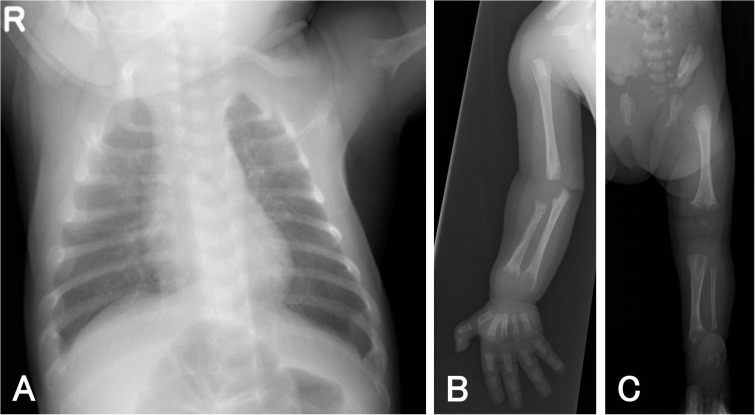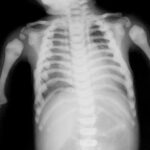Infantile hypophosphatasia (HPP) is a rare genetic disorder that affects bone mineralization, leading to skeletal deformities, respiratory issues, and severe developmental concerns. This condition occurs due to mutations in the ALPL gene, which encodes the tissue non-specific alkaline phosphatase enzyme (TNSALP).

Causes and Genetic Basis
Infantile hypophosphatasia results from mutations in the ALPL gene. This gene provides instructions for producing TNSALP, an enzyme essential for bone mineralization. Mutations disrupt TNSALP function, causing inadequate breakdown of certain substances like pyrophosphate, which in turn inhibits bone formation.
Inheritance Pattern
- Autosomal Recessive: Most severe forms, including infantile HPP, are inherited in this pattern. Both parents must carry a defective gene.
- Autosomal Dominant: Milder cases may follow this inheritance.
Symptoms of Infantile Hypophosphatasia
Symptoms generally appear before six months of age and may include:
- Skeletal Deformities: Bowed limbs, shortened bones, and rib cage abnormalities.
- Respiratory Issues: Chest deformities may impair breathing.
- Failure to Thrive: Poor feeding and slow growth.
- Craniosynostosis: Premature skull suture closure, causing head shape abnormalities.
- Hypercalcemia: Elevated calcium levels may lead to vomiting, irritability, and kidney problems.
Severe Complications
- Seizures due to low vitamin B6-dependent neurotransmitter activity.
- Increased Fracture Risk with minimal trauma.
Diagnosis of Infantile Hypophosphatasia
Key Diagnostic Methods
- Blood Tests: Low alkaline phosphatase (ALP) levels are a hallmark.
- Radiographic Imaging: Reveals characteristic skeletal defects.
- Genetic Testing: Identifies mutations in the ALPL gene.
Differential Diagnosis
Conditions such as rickets, osteogenesis imperfecta, and other metabolic bone disorders must be ruled out.
Treatment Options for Infantile Hypophosphatasia
Treatment strategies focus on managing symptoms and improving quality of life. Key approaches include:
Enzyme Replacement Therapy (ERT)
- Asfotase Alfa (Strensiq®): The primary treatment for infantile HPP. It significantly improves bone mineralization, respiratory function, and survival rates.
Supportive Care
- Pain Management: Using analgesics or physiotherapy.
- Respiratory Support: Assisted ventilation if breathing complications occur.
- Nutritional Support: Managing hypercalcemia and improving growth with tailored dietary plans.
Surgical Interventions
In severe cases, surgery may be required to correct skeletal deformities or address craniosynostosis.
Prognosis and Long-term Outlook
Prognosis varies depending on symptom severity and treatment response. Early intervention, particularly with enzyme replacement therapy, significantly improves survival and developmental outcomes. Without appropriate treatment, infantile hypophosphatasia can be life-threatening.
Prognostic Factors
- Age at Onset: Earlier symptoms often indicate more severe progression.
- Treatment Initiation: Timely enzyme therapy improves outcomes.
Preventive Measures and Genetic Counseling
Since HPP is a genetic disorder, families with a known history should consider genetic counseling. Prenatal testing may identify carriers or predict potential risks in unborn children.
Frequently Asked Questions:
What is the main cause of infantile hypophosphatasia?
Infantile hypophosphatasia is caused by mutations in the ALPL gene, affecting bone mineralization.
How is infantile hypophosphatasia diagnosed?
Diagnosis involves blood tests (low ALP), genetic testing for ALPL mutations, and X-rays for skeletal abnormalities.
Can infantile hypophosphatasia be cured?
While there is no permanent cure, enzyme replacement therapy (ERT) with Asfotase Alfa effectively manages the condition.
Is infantile hypophosphatasia hereditary?
Yes, infantile HPP is typically inherited in an autosomal recessive pattern.
What are the survival rates for infants with hypophosphatasia?
With early diagnosis and proper treatment, survival rates improve considerably, though severe cases may remain challenging.
Infantile hypophosphatasia is a complex yet manageable condition with advances in enzyme replacement therapy offering hope for improved outcomes. Early diagnosis, vigilant management, and supportive care remain crucial for enhancing the quality of life for affected infants.

